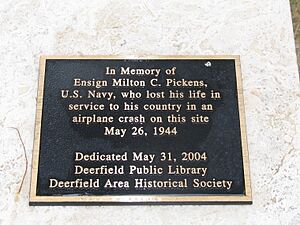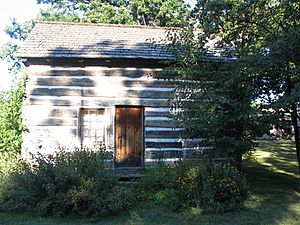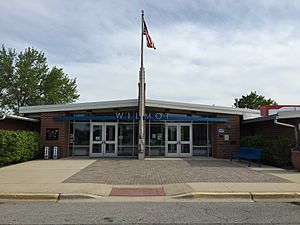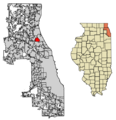Deerfield, Illinois facts for kids
Quick facts for kids
Deerfield, Illinois
|
|||
|---|---|---|---|
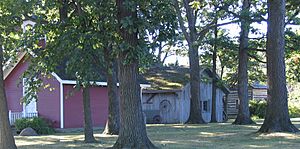
Deerfield Historic Village
|
|||
|
|||
| Motto(s):
"The community that lives and works together"
|
|||

Location of Deerfield in Lake and Cook counties, Illinois
|
|||

Location of Illinois in the United States
|
|||
| Country | United States | ||
| State | Illinois | ||
| Counties | Lake, Cook | ||
| Township | West Deerfield, Moraine, Vernon | ||
| Founded | 1903 | ||
| Named for | Deerfield, Massachusetts | ||
| Government | |||
| • Type | Council–manager government | ||
| Area | |||
| • Total | 5.55 sq mi (14.38 km2) | ||
| • Land | 5.53 sq mi (14.32 km2) | ||
| • Water | 0.02 sq mi (0.06 km2) | ||
| Population
(2020)
|
|||
| • Total | 19,196 | ||
| • Density | 3,471.25/sq mi (1,340.21/km2) | ||
| Time zone | UTC-6 (CST) | ||
| • Summer (DST) | UTC-5 (CDT) | ||
| ZIP Code |
60015
|
||
| Area codes | 847, 224 | ||
| FIPS code | 17-18992 | ||
| Wikimedia Commons | Deerfield, Illinois | ||
Deerfield is a village located in Lake and Cook counties in the U.S. state of Illinois. It's a northern suburb of Chicago, found on the North Shore. Deerfield is about 28 miles north of downtown Chicago. In 2020, about 19,196 people lived there.
Deerfield is home to the main offices of big companies like Walgreens Boots Alliance and Baxter Healthcare. It's known as one of the wealthiest places in Illinois and the Midwest. In 2022, the average household income in Deerfield was $185,762.
Contents
History of Deerfield
Early Beginnings
The land where Deerfield now stands was first home to Native American tribes like the Potawatomi, Miami, Kickapoo, and Peoria. In 1835, two settlers, Horace Lamb and Jacob B. Cadwell, arrived and named the area Cadwell's Corner. You can still find a shopping center with this name today. The area grew because of nearby rivers like the Des Plaines River.
By 1840, the town's name changed to "Leclair." About ten years later, a settler named John Millen suggested calling it "Deerfield." He chose this name to honor his hometown, Deerfield, Massachusetts, and because many deer lived in the area. The community voted, and "Deerfield" won by a small margin.
The first school in the village, Wilmot School, opened in 1847. It started as a small, one-room schoolhouse. Today, Wilmot is an elementary school serving many students. It's built on land given by Lyman Wilmot, whose wife, Clarissa, was the village's first teacher. Deerfield officially became a village in 1903, with a population of just over 400 people.
In the 1850s, Lyman Wilmot's home in Deerfield was a secret stop on the Underground Railroad. This was a network of safe houses that helped enslaved people escape to freedom in Canada.
Deerfield in the 20th Century
In 1917, a famous architect named Thomas E. Tallmadge suggested that Deerfield could be the center of a new capital city for the United States. By this time, all the original farms in Deerfield had become either neighborhoods or golf courses.
On May 26, 1944, a U.S. Navy plane crashed in Deerfield where the Public Library is now located. The pilot, Ensign Milton C. Pickens, sadly died. After World War II, a part of Illinois Route 43 that goes through Deerfield was named a Blue Star Memorial Highway. This honors those who served in the armed forces.
In 1959, there was a big discussion in Deerfield. A builder wanted to create new homes that would be available to all people. Village officials stopped the work, leading to a community debate about housing and land use. The village eventually voted to build parks on the land instead. These parks are now known as Mitchell Pool and Park and Jaycee Park. Later, in 2020, Mitchell Park was renamed Floral Park.
Since the early 1980s, Deerfield has become more diverse. More people from Jewish, Asian, and Greek backgrounds have moved to the community.
On June 27, 1962, the Kitchens of Sara Lee company started building what would become the world's largest bakery in Deerfield. This huge plant began making products in 1964. It was very modern, with automated systems. President Ronald Reagan even visited the plant in 1985. The bakery closed in 1990, and Sara Lee's main offices moved away by 1991.
In 1982, Deerfield started a community farm project. About 200 residents signed up for garden plots on a 3-acre area. The project was so successful that the village opened more community farms on empty land.
By 1987, most of Deerfield was made up of single-family houses. The prices for these homes ranged from $100,000 to $300,000. Most of the town's land was used for houses, and there wasn't much empty land left for new buildings.
Deerfield in the 21st Century
On December 19, 2005, Deerfield passed a strict anti-smoking law. This law made it illegal to smoke in all public places, including businesses, restaurants, parks, and even within 25 feet of these places.
In November 2007, BusinessWeek.com ranked Deerfield as the third best place to raise children. They looked at things like school test scores, cost of living, fun activities, and safety.
In 2015, there was a plan to change the rules for a piece of land. The idea was to build a 48-apartment complex for affordable housing. Some Deerfield residents did not agree with this plan.
Deerfield used to be a "Sister City" with Lüdinghausen, Germany. This program helps build friendships between cities in different countries. However, the program ended in October 2019 because it wasn't very active anymore.
Deerfield Historic Village
In front of Kipling Elementary School, you can find the Deerfield Historic Village. This outdoor museum is run by the Deerfield Area Historical Society. It has five old buildings and is also where the Historical Society has its offices. You can take tours during the summer.
The Historic Village includes the Caspar Ott House, built in 1837. This is thought to be the oldest building in Lake County. The Ott family used this house to help enslaved people on the Underground Railroad. The George Luther House, built in 1847, now holds the Society's offices. The Bartle Sacker Farmhouse from 1854 shows what a typical 19th-century home looked like. While these buildings are original (though moved from their first spots), the carriage house and little red school house are copies. Every year, all fourth graders in Deerfield School District 109 spend a day learning in the school house.
Deerfield's Geography
Deerfield covers about 5.55 square miles. Most of this area, about 5.53 square miles, is land, and a small part, about 0.02 square miles, is water.
Deerfield shares its borders with several other towns. To the north is Bannockburn, to the east is Highland Park, to the south is Northbrook, and to the west is Riverwoods.
Population and People
| Historical population | |||
|---|---|---|---|
| Census | Pop. | %± | |
| 1910 | 476 | — | |
| 1920 | 610 | 28.2% | |
| 1930 | 1,852 | 203.6% | |
| 1940 | 2,283 | 23.3% | |
| 1950 | 3,288 | 44.0% | |
| 1960 | 11,786 | 258.5% | |
| 1970 | 18,876 | 60.2% | |
| 1980 | 17,432 | −7.6% | |
| 1990 | 17,327 | −0.6% | |
| 2000 | 18,420 | 6.3% | |
| 2010 | 18,225 | −1.1% | |
| 2020 | 19,196 | 5.3% | |
| U.S. Decennial Census 2010 2020 |
|||
In 2020, Deerfield had 19,196 people living there. There were 7,323 households and 5,574 families. The population density was about 3,457 people per square mile.
Most people in Deerfield are White (87.82%). There are also people who identify as African American (0.71%), Native American (0.12%), and Asian (5.30%). About 4.14% of the population is Hispanic or Latino.
About 34.9% of households had children under 18. Most households (68.50%) were married couples. The average household had about 3 people.
The median age in the village was 44.2 years. About 25.5% of the population was under 18 years old.
The median income for a household was $162,064, and for a family it was $189,125. About 2.7% of the total population lived below the poverty line.
| Race / Ethnicity (NH = Non-Hispanic) | Pop 2000 | Pop 2010 | Pop 2020 | % 2000 | % 2010 | % 2020 |
|---|---|---|---|---|---|---|
| White alone (NH) | 17,434 | 16,797 | 16,649 | 94.65% | 92.00% | 86.73% |
| Black or African American alone (NH) | 58 | 93 | 131 | 0.31% | 0.51% | 0.68% |
| Native American or Alaska Native alone (NH) | 7 | 4 | 7 | 0.04% | 0.02% | 0.04% |
| Asian alone (NH) | 465 | 660 | 1,015 | 2.52% | 3.62% | 5.29% |
| Pacific Islander alone (NH) | 3 | 2 | 1 | 0.02% | 0.01% | 0.01% |
| Other race alone (NH) | 21 | 25 | 47 | 0.11% | 0.14% | 0.24% |
| Mixed race or Multiracial (NH) | 120 | 164 | 552 | 0.65% | 0.90% | 2.88% |
| Hispanic or Latino (any race) | 312 | 510 | 794 | 1.69% | 2.80% | 4.14% |
| Total | 18,420 | 18,225 | 19,196 | 100.00% | 100.00% | 100.00% |
Deerfield's Economy
Business Growth
In 1982, a special area was created along Lake-Cook Road to encourage new businesses. This helped many companies move to Deerfield. Throughout the 1980s, many office buildings were built there. Two hotels, an Embassy Suites and a Hyatt, also opened to serve business travelers. This growth happened because of the new business area, available land, and its closeness to Chicago and O'Hare International Airport.
Company Headquarters
Deerfield is home to the main offices of several large companies. These include Baxter Healthcare, Beam, Big Apple Bagels, CF Industries, Fortune Brands Home & Security, Essendant, and Walgreens Boots Alliance. As of 2021, Walgreens Boots Alliance was the biggest employer in Deerfield, with 6,500 employees at its headquarters.
Deerfield was also once home to the headquarters of Consumers Digest, Così, and the bakery division of Sara Lee Corporation. In 1987, Sara Lee had about 1,200 employees in Deerfield.
Top Employers
As of 2021, these are some of the biggest employers in Deerfield:
| # | Employer | # of Employees |
|---|---|---|
| 1 | Walgreens Boots Alliance | 6,500 |
| 2 | Walgreens | 2,500 |
| 3 | Alera Group | 1,900 |
| 4 | Baxter International | 1,700 |
| 5 | Baxter Healthcare | 800 |
| 6 | Essendant | 800 |
| 7 | Deerfield Park District | 500 |
| 8 | Trinity International University | 500 |
| 9 | Deerfield School District 109 | 415 |
| 10 | CF Industries | 350 |
Shopping Areas
In 1998, a large part of downtown Deerfield was rebuilt. It became a new outdoor shopping area called Deerfield Square. It has many different stores and restaurants. Deerfield Square also has offices and an outdoor plaza where free concerts are held in the summer.
Deerbrook Mall is another shopping area near the border of Deerfield and Northbrook. When it first opened in 1971, it had both indoor and outdoor shops. The indoor part was taken down in 2017.
Close to Deerbrook Mall is Caldwell Corners, a smaller outdoor mall. It uses the village's original name. The Deerfield Public Library used this mall as a temporary location in 2012 and 2013 while its main building was being updated.
Education in Deerfield
Public Schools
Deerfield has public schools run by Deerfield School District 109. This district has four elementary schools: Kipling, South Park, Walden, and Wilmot. It also has two middle schools: Caruso and Shepard. Most students from Deerfield go on to attend Deerfield High School. A small number attend Highland Park High School. Both high schools are part of Township High School District 113. Deerfield High School is often ranked as one of the best schools in Illinois.
In the past, District 109 had more elementary schools. But some, like Maplewood and Briarwood, were closed in the 1970s and 1980s. Their students then went to the four larger schools that remain today.
Private Schools
Deerfield is home to Rochelle Zell Jewish High School, a private Jewish school. There are also a few Montessori schools. Holy Cross School, a Catholic elementary and middle school, used to be in Deerfield but closed in 2018.
Colleges and Universities
Trinity International University, a private Christian university, has its main campus in Deerfield. Trinity Evangelical Divinity School is also located on this campus. The main office of the World Evangelical Alliance is also here.
Getting Around Deerfield
Transportation
Deerfield has two Metra train stations: Deerfield and Lake Cook Road. These stations connect the village to Chicago Union Station. Several Pace buses also run in Deerfield, connecting the train stations to local businesses during busy times.
Two Amtrak trains, the Empire Builder and the Hiawatha, pass through Deerfield but do not stop there. Deerfield is connected to major roads and highways, including Deerfield Road, Lake-Cook Road, Illinois Route 43, I-94, and I-294. The closest airport is O'Hare International Airport. Deerfield also has many bike trails that connect to nearby towns, Lake Michigan, the Chicago Botanic Garden, and the Des Plaines River Trail.
Utilities
The village buys its water from Highland Park and then distributes it to homes and businesses. There's also an emergency water line to Northbrook if either town loses water. Deerfield has its own sewage treatment plant that cleans wastewater before it goes into a branch of the Chicago River. A new plant was finished in 2013.
Lakeshore Recycling handles trash, recycling, and composting services in Deerfield. Deerfield is part of a program that lets residents buy solar energy credits to use for their electricity bills. North Shore Gas provides natural gas to Deerfield.
Famous People from Deerfield
Many notable people have lived in or are from Deerfield:
- Paul Adams, a football coach at Deerfield High School.
- Alexander 23, a singer, songwriter, and record producer.
- Robert Bell, who played Bozo the Clown in Chicago.
- Dean Bernardini, a rock musician from the band Chevelle.
- Karl Berning, an Illinois state senator.
- Alex Borstein, an actress known for voicing Lois Griffin on Family Guy.
- Colt Cabana, a professional wrestler.
- Joey Calistri, a professional soccer player.
- Cory Everson, a fitness model and bodybuilder.
- Brenda A. Ferber, a children's book author.
- Tim Floyd, a former coach for the Chicago Bulls.
- Gale Gand, a pastry chef and Food Network personality.
- Ross Golan, a multi-platinum songwriter and producer.
- Pete Jones, a writer and director.
- Lindsay Knapp, a former NFL player for the Green Bay Packers.
- Kevin McCollum, an actor and Broadway producer.
- Aaron Moorehead, a former NFL player for the Indianapolis Colts.
- Bruce Rauner, the 42nd Governor of Illinois.
- Ellie Reed, an actress.
- Todd Reirden, an NHL coach and former player.
- Brad Schneider, a U.S. Representative.
- Art Shay, a famous photojournalist.
- Fred L. Turner, a retired chairman and CEO of McDonald's Corp.
- T. J. Tynan, a professional hockey player.
- Daniel Walker, the 36th Governor of Illinois.
- Charlie Jones, an NFL player for the Cincinnati Bengals.
Images for kids
-
The Metra train station in Deerfield
See also
 In Spanish: Deerfield (Illinois) para niños
In Spanish: Deerfield (Illinois) para niños



